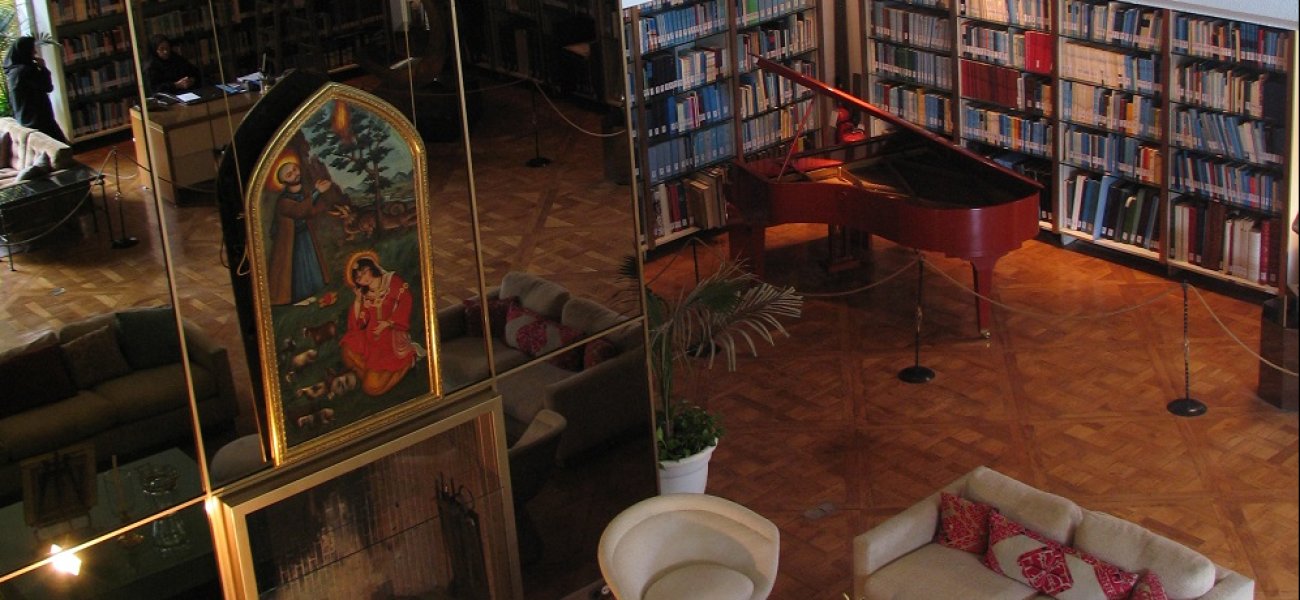Hour 13:16
21 Oct 25

Niavaran Royal Library was established in 1976 in the northeastern part of Niavaran Complex, adjacent to the residential quarters of Pahlavi Royal family. It consists of two floors and a basement, with a total area of 770 square meters.
Niavaran Royal Library Museum
Niavaran Royal Library was established in 1976 in the northeastern part of Niavaran Complex, adjacent to the residential quarters of Pahlavi Royal family. It consists of two floors and a basement, with a total area of 770 square meters.
The structure was designed and constructed by renowned Iranian architect Abdol-Aziz Farmanfarmaian, while the interior decoration was undertaken by Charles Sevigny, a prominent American designer of that era; inspired by Iranian Chaharivani layouts (Persian four-iwan plan) and the use of dark-toned mirror panels that reflect light, Sevigny created a sophisticated blend of glass, mirror, and bronze, resulting in a distinct and elegant interior.
As the space was intended for private use, it does not conform to standard library layouts. The presence of a piano and audio equipment suggests that it also functioned as a music room. Artistic furnishings, sculptures, and paintings enhance the atmosphere and lend the space a distinctly museum character; and the unique lighting feature consisting of 4,356 crystal cylinders and 120 fluorescent bulbs adds to the visual identity of the library.
Here with in the collection notable artworks by both Iranian and international artists such as Parviz Tanavoli, Masoud Arabshahi, Bahman Mohasses, Manoucher Yektai, Mohammad Madbor, César Baldaccini, Diego Giacometti, Arnaldo Pomodoro, and Armand (Pierre Armand Fernandez) can be found throughout the space.
The library houses more than 23,000 printed volumes across 16,000 titles, covering a broad range of subjects including culture, literature, sociology, statistics, encyclopedias, art history, archaeology, and world civilizations. Particular emphasis is placed on works related to Iranian history, French literature, and painting. The collection also includes many rare first editions of travelogues by renowned figures, as well as complete collections of publications by the University of Tehran and the Iran Cultural Foundation, many bound in royal blue leather.
Among its unique features are books presented by global dignitaries and notable writers, including John F. Kennedy, Walt Disney, Jawaharlal Nehru, Rolf Bennie, Roman Ghirshman, Parvin E’tesami, Ali-Naqi Vaziri, and Manouchehr Atashi.
The library also preserves valuable manuscripts by prominent calligraphers such as Mir Ali Heravi, Ahmad Nayrizi, Vesal Shirazi, Zeyn al-Abedin Hosseini, Mohammad Esfahani, and Mohammad Taqi Mashhadi. The library’s art collection includes over 350 paintings by celebrated artists such as Jafar Rohbakhsh, Mansoureh Hosseini, Nasser Ovissi, Abolghassem Saeedi, Mahmoud Farshchian, Salvador Dalí, Joan Miró, Andy Warhol, and Alain Buyach.
Many of the printed books themselves are considered collectible artworks, thanks to their exquisite bindings and cases—ranging from engraved leather boxes to inlaid wooden, metalworked, and bejeweled containers. The smallest book in the collection is a Qur’an measuring 5 × 8 cm, while the largest is a Latin-language atlas measuring 57 × 82 cm.
The oldest non-Persian book is a 1609 Latin edition of The History of the Jewish People by Josephus Flavius, published in Paris and the oldest Persian book is a copy of Hafez’s Divan with commentary by the Bosnian scholar Sudi, printed in Leipzig in 1873 and gifted to Naser al-Din Shah Qajar.
After the 1979 revolution, the library’s cataloging and classification were completed by a team of experts between 2002 and 2004. Books were indexed using the Library of Congress (LC) classification system and entered into bilingual (Persian-English) databases for research and reference. Prior to that, during Pahlavi era, classification was being done according to the Dewey Decimal System but was never completed.
In 2004, Niavaran Royal Library officially opened to the public as a museum, offering researchers and visitors a rare glimpse into the intellectual and artistic world of Iran’s modern royal era.